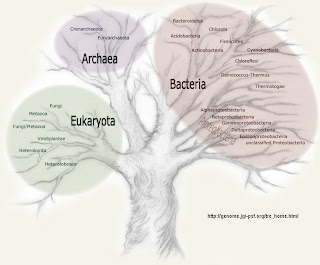
Last week, before leaving for Halifax, I had lunch with David Schuller (a Monday's Molecule winner) and Deb Breiter. They were in town for a meeting of crystallographers.
We talked about biochemistry education (among other things) and it was fun to hear the perspective of someone who teaches introductory biochemistry at a smaller college in the mid-west. (Deb is head of the Department of Chemistry and Biochemistry at
Rockford College in Illinois.)
The issues she faces are very different than those at a big school like the University of Toronto. Naturally we talked about textbooks and, after scolding her for not using my book, we debated the merits of various introductory biochemistry textbooks. (She has used several different ones and is very knowledgeable on the topic.)
Part of the debate revolves around differing approaches to teaching introductory biochemistry. There are many variations but I like to think of two main ones that I refer to as the "Evolutionary Approach" and the "Fuel Metabolism" approach.
1 Keep in mind that these are just broad categories used to illustrate some points about how to teach biochemistry.
The Evolutionary Approach to biochemistry emphasizes universal concepts that apply to most organisms. It concentrates on comparative aspects of biochemistry and on explanations of where things come from. This approach will almost always include lectures on photosynthesis and will almost always try to explain how metabolic pathways evolve.
In the Evolutionary Approach, the fundamental pathways of lipids, carbohydrates, amino acids etc. are the biosynthetic ones and not the degradation pathways. Some concepts, like the idea of essential amino acids, are relegated to footnotes. Human biochemistry is treated as a specialized version of the big picture and the fundamental concepts are taught first using simple prokaryotic examples.
The Fuel Metabolism Approach is quite different. Here the emphasis is on human biochemistry and almost everything is treated as a potential fuel before its biosynthesis is discussed. Photosynthesis isn't covered in such a course and the biochemistry of bacteria is usually not mentioned. This is the kind of course that's geared for students who are interested in their own metabolism and (it is thought) for pre-medical students.
In the Fuel Metabolism approach, students will learn that gluconeogenesis isn't very important and that there's a big difference between essential and nonessential amino acids. They will learn that the carbons in fatty acids can rarely be converted to carbohydrates. They will study transcription, translation, and DNA replication as they occur in mammals and they usually won't be exposed to the prokaryotic versions of information flow.
I think that the Evolutionary Approach to biochemistry is superior to the older Fuel Metabolism approach. In part, this is because the Evolutionary Approach encourages a "big picture" view of biochemistry where the ideas are more important than the facts. In contrast, the Fuel Metabolism approach encourages the learning of specific pathways since, by and large, it is confined to discussing mammals.
On the other hand, the Fuel Metabolism Approach may be more appealing to students because they are more concerned about themselves than about other species. Furthermore, it lends itself to discussions about diet and nutrition and these are hot topics that attract students.
I learned a lot from Deb Breiter. One of the most important things was that teachers like her get together from time to time to discuss how to teach chemistry/biochemistry. The meetings I attend are dominated by people who write textbooks and run BAMBED (Biochemistry and Molecular Biology Education) and we don't have much contact with many of those on the front line. (Don't get me wrong, most of us at those meetings are also teachers, it's just that we tend to forget that the vast majority of biochemistry teachers aren't even aware of some issues.)
Deb belongs to a group called the "Midwestern Association of Chemistry Teachers in Liberal Arts Colleges" (MACTLAC). The
MACTLAC 2009 Annual Meeting is at Hope College in Michigan on Oct. 16-17. It would be fun to attend—I wonder if they allow interlopers?
1. Many textbook authors refer to the Fuel Metabolism Approach as "rat liver" biochemistry but I won't mention that here because it sounds like I'm taking sides. 
 Most of us don't know very much about slugs and land snails but Christopher Taylor at Catalogue of Organisms is doing his best to educate us (and himself): Wild Slug Chases (Taxon of the Week: Gastrodontoidea).
Most of us don't know very much about slugs and land snails but Christopher Taylor at Catalogue of Organisms is doing his best to educate us (and himself): Wild Slug Chases (Taxon of the Week: Gastrodontoidea).
















